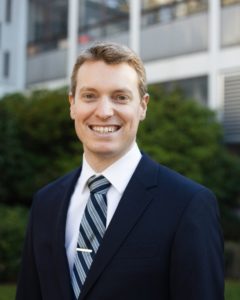|
|
Zachary M. Hudson is an Associate Professor and Canada Research Chair in Sustainable Chemistry at the University of British Columbia. Zac completed his B.Sc. at Queen’s University in Kingston, Ontario. He remained at Queen’s to pursue a Ph.D. in Inorganic Chemistry under the supervision of Prof. Suning Wang, focusing on the development of luminescent materials for organic electronics. During his Ph.D. he also held graduate fellowships at Jilin University in China as well as Nagoya University in Japan. He then moved to the University of Bristol as a Marie Curie Postdoctoral Fellow with Prof. Ian Manners, followed by a second Postdoctoral Fellowship at the California Nanosystems Institute at the University of California, Santa Barbara with Prof. Craig Hawker. He joined the faculty at UBC in 2015, where he holds the Canada Research Chair in Sustainable Chemistry. He leads a research program in synthetic materials chemistry, studying topics ranging from solutions for energy-efficient displays and light sources to the self-assembly of electronic materials on the nanoscale. He was the recipient of the ACS Herman Mark Young Scholar Award and Polymer International-IUPAC Award in 2022. |
Read Zachary’s Emerging Investigator article, ‘Donor modification of thermally activated delayed fluorescence photosensitizers for organocatalyzed atom transfer radical polymerization’
Check out our interview with Zachary below:
1. How do you feel about Polymer Chemistry as a place to publish research on this topic?
Polymer Chemistry is the perfect place to read about innovative techniques in polymer synthesis, and we’re excited to contribute an article with a photophysical twist.
2. What aspect of your work are you most excited about at the moment and what do you find most challenging about your research?
I’m very excited about our work on luminescent polymer dots, or Pdots – nanoparticles that can be bright enough to be detected with a handheld smartphone camera. We’re collaborating with my colleague Russ Algar at UBC to develop nanoparticles for biosensing using smartphones, and translating this to technology that could be used in a healthcare setting represents a major exciting challenge.
3. In your opinion, what are the most important questions to be asked/answered in this field of research?
Our current featured article uses organic photosensitizers as catalysts for controlled radical polymerization. In this space, we need to develop highly photostable sensitizers that can perform using visible light irradiation. This is a major challenge, because accessing suitably high-energy excited states using visible light is itself a contradictory requirement.
4. Can you share one piece of career-related advice or wisdom with other early career scientists?
I’m a big fan of ‘white space’ in my calendar – time in which nothing is booked, so I have the space to just read or think. The hectic lifestyle of early-career academia combined with our always-connected culture makes it hard to find time to just think about science – schedule it if you have to!











